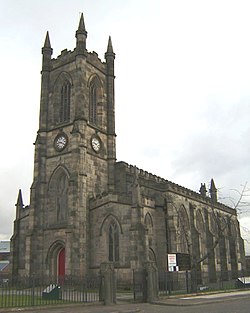Pendleton, Salford
| Pendleton | |
| Lancashire | |
|---|---|
 The parish church of St Thomas, Pendleton | |
| Location | |
| Grid reference: | SJ812991 |
| Location: | 53°29’31"N, 2°16’55"W |
| Data | |
| Postcode: | M6 |
| Dialling code: | 0161 |
| Local Government | |
| Council: | Salford |
| Parliamentary constituency: |
Salford and Eccles |
Pendleton is an inner city area of Salford in Lancashire, about two miles from Manchester city centre. The A6 dual carriageway skirts the east of the area. It experienced rapid urbanisation during the Industrial Revolution.
Pendleton is a densely populated area which has several high-rise blocks of flats – typically between 17 and 27 storeys high. The area has two colleges; Pendleton College and a Salford College campus, Salford's largest shopping precinct, Salford Shopping City and Pendleton Police Station.
History
The township has been variously recorded as Penelton in 1199, Pennelton in 1212, Penilton in 1236, Penhulton in 1331, Penulton in 1356 and Pendleton from about 1600.[1]
In the Middle Ages the manor was held by the Hultons of Hulton Park.[2]
Until 1780 the village was rural, a group of cottages around a village green with a maypole. The Industrial Revolution brought about rapid expansion in the population and large cotton mills and premises for dyeing, printing, and bleaching were built providing employment. Pendleton Colliery was developed from the early-19th century.[2]
Geography
Pendleton is 2½ miles north-west of Manchester city centre by the River Irwell and at the junction roads to Liverpool, Preston, Bolton and Manchester. The Manchester, Bolton & Bury Canal, the Liverpool and Manchester and Manchester and Bolton railways pass through the area.[2]
Pendleton is situated on the coal measures of the Manchester Coalfield, part of Lancashire Coalfield. In the early days of coal mining seams lying on or close to the surface were exploited, but as time went by deeper shafts were sunk to exploited deeper coal seams so that by the beginning of the 20th century Pendleton Colliery had the deepest shafts in Great Britain, at 3,474 ft.[3]
The area gives its name to the geological feature known as the Pendleton Fault, one of four large faults running under the Manchester area. The faults are geologically active, and cause earthquake tremors that have been recorded for centuries, most recently in August 2007, when Manchester experienced six minor earthquakes.[4]
Clarendon Park is within the bounds of Pendleton. The largest public park is Buile Hill Park which lies on high ground adjacent to Eccles Old Road.
Transport
Pendleton railway station closed in 1998 after it was damaged in an arson attack.[5] Salford Crescent railway station links the district and the University of Salford, central Manchester stations (Piccadilly, Oxford Road and Victoria) and towns in the north.
Parish church
St Thomas Church, a Commissioners' Church,[2] is the parish church. It replaced the original chapel. It was built in 1829–31 to the design of Francis Goodwin and Richard Lane in a Perpendicular gothic revival style with a west tower and three galleries.[6]
Notable people
The 19th century industrialist and Liberal politician Sir Elkanah Armitage lived at Hope Hall from 1853 until his death in 1876. The cartographer, printer and publisher George Bradshaw was born in 1801[7] and James Agate the theatre critic was also born here.[8]
Tommy White, the Everton and England footballer was born in Pendleton.[9] Pat Kirkwood, who became one a stars of musical theatre, was born in Pendleton,[10] and the actors Albert Finney, born in the Charlestown area and baptised at St George's Church, Charlestown, and Christopher Eccleston, known for his role in the TV series Doctor Who, was brought up in Langworthy.
References
Notes
- ↑ Farrer, William; Brownbill, J, eds. (1907), "Pendleton", A History of the County of Lancaster: Volume 4 (British History Online): pp. 392–396, http://www.british-history.ac.uk/report.aspx?compid=41443, retrieved 17 February 2011
- ↑ 2.0 2.1 2.2 2.3 Lewis, Samuel (1848), "Pendleton", A Topographical Dictionary of England (British History Online): pp. 545–549, http://www.british-history.ac.uk/report.aspx?compid=51208, retrieved 17 February 2011
- ↑ Mullineux 1973, pp. 47–48
- ↑ Malvern, Jack (31 August 2007), "The Earth Moves for Manchester", The Times, http://www.timesonline.co.uk/tol/news/uk/article2358111.ece, retrieved 27 February 2010
- ↑ Regulator allows closure of Pendleton station, Office of Rail Regulation, 15 December 1998, http://www.rail-reg.gov.uk/server/show/ConWebDoc.5546, retrieved 27 March 2008
- ↑ Pevsner, N. (1969) Lancashire, vol. 1. Penguin Books
- ↑ Kelly, Laura (21 June 2010). "Christopher Eccleston". The Big Issue. http://www.bigissuescotland.com/features/view/298. Retrieved 22 November 2010.
- ↑ Brown, Ivor; Brodie, Marc (rev.) (2004), "Agate, James Evershed (1877–1947)", Oxford Dictionary of National Biography (online ed.), Oxford University Press, http://www.oxforddnb.com/view/article/30346, retrieved 27 February 2010
- ↑ Joyce, Michael (2004). Football League Players' Records 1888 to 1939. Nottingham: Tony Brown. p. 255. ISBN 1-899468-67-6.
- ↑ BBC NEWS Entertainment Obituary: Pat Kirkwood, BBC News Online, http://news.bbc.co.uk/1/hi/entertainment/7160161.stm, retrieved 2014-02-28
Bibliography
- Mullineux, F. (1973), "Coal Mining in Lancashire", in Smith, J. H., The Great Human Exploit: Historic Industries of the North-West, Phillimore & Co, ISBN 0-85033-108-0